| 10 |
Panama: visits to sanitary districts |
| 10.1 |
Ancon and Balboa |
The city of Panama and the town of Ancon are, as I said before, divided from each other only by a street. Ancon is built on the sides of Ancon Hill, which slopes off into the sea as a low rocky promontory; and on this is the city of Panama. On the east this promontory runs off into undulating land, called the Savannahs, well above the level of the sea; while on the west there is a mangrove swamp which curves to the north of Ancon Hill. So these towns are really cut off on the landward side by mangrove swamp. On the higher slopes of Ancon Hill are the Administration buildings and the hospital. The swamp below is being filled in. Originally the swamp was drained; but at the time of my visit the original drainage system had been obliterated by “filling” to a depth of about 6 feet. This will be an advantage ultimately; in the meantime, however, the area demands greater supervision, and an increased expenditure on oil.
The stone being “dumped” was from the Culebra Cut. Hard enough to require blasting in the Cut, when once exposed to the air it weathers very rapidly; and stone only a month out could often be kicked into a fine black powder. It is really a compressed volcanic ash. For a year or two it remains porous; then it becomes almost impervious to water, as the Department found to its cost after using it as a covering to the subsoil pipes.
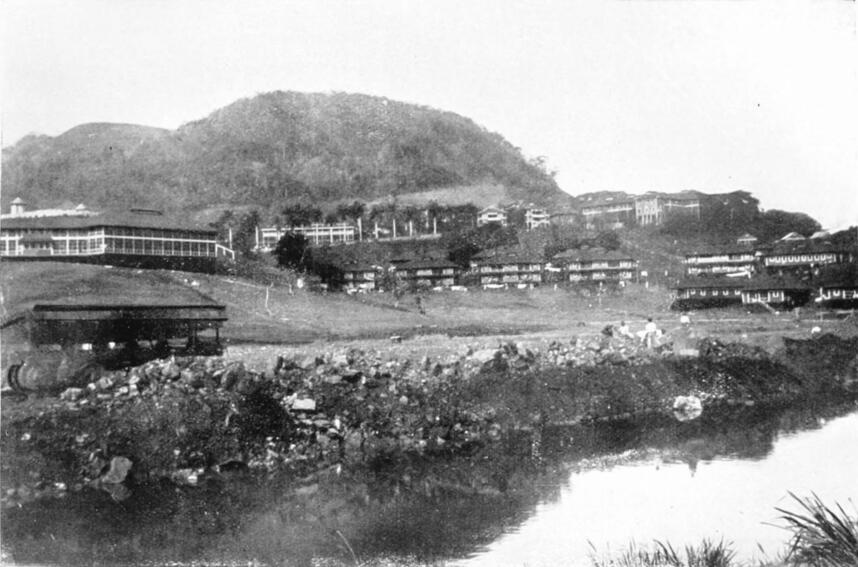
Ancon was not the only place where the drainage had been obliterated by the engineers in disposing of the spoil from the Cut. When we remember that the material excavated from the Canal amounts to 212,000,000 cubic yards of earth, and that every additional yard this has to be conveyed adds to the cost of the Canal, we can understand the “dumps” must be numerous, and must affect to a considerable degree the physical and hydraulic conditions of the country. On the “dump” were fly-proof latrines for the labourers employed.
After visiting the larvicide factory, which is connected by rail with the railway system, and after examining some drains where the grass had been burnt off the sides, we walked across the new “filling” to the labourers’ quarters, and examined a “range latrine.” This is a trough latrine, flushed by siphon action; but, as during most of the day and night it is not used, water is saved by putting the siphon into action only at certain hours. We also inspected some of the subsoil drains, which are always covered by stone; and here, as shown in Figure 10.2, terminate under a cement cover to prevent damage to the railway track. Following the railway, we found it went off from the hill at a tangent direct for Sosa Hill, past the west side of which runs the Canal.
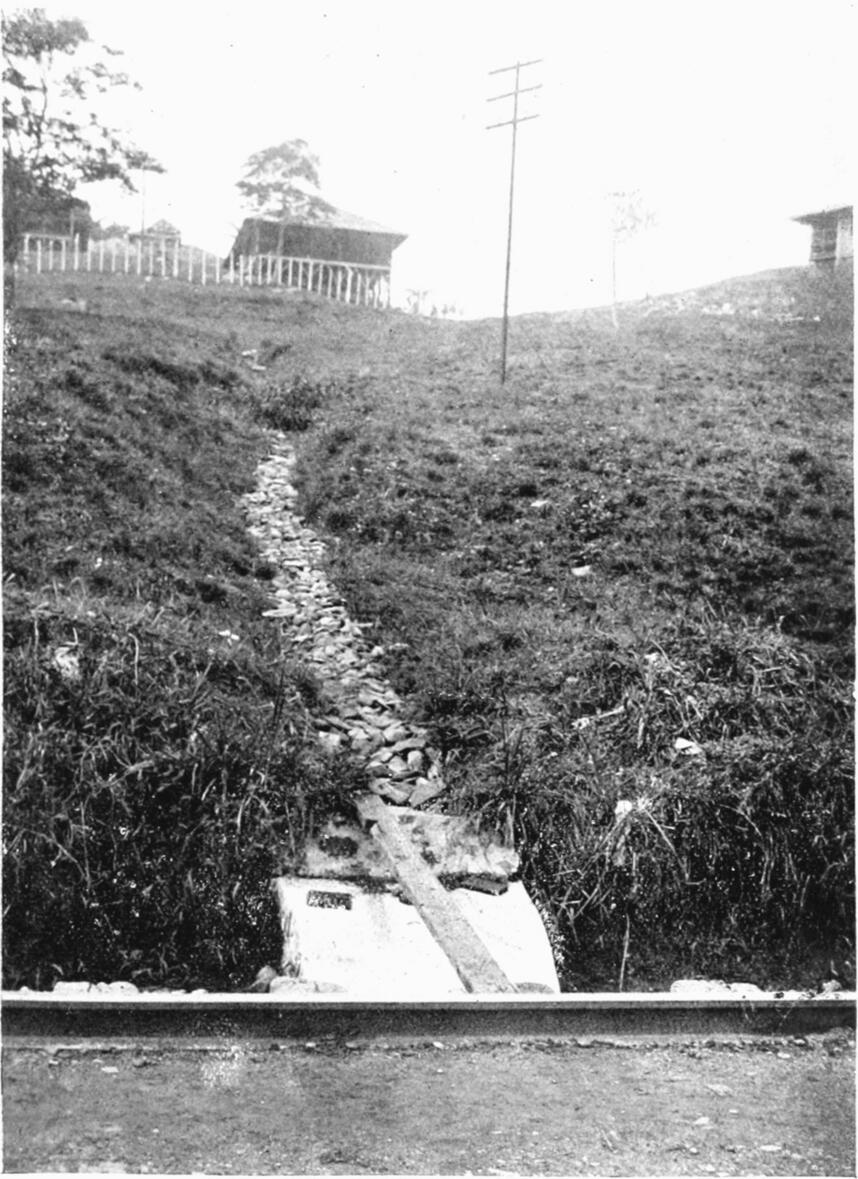
Between Sosa Hill and Ancon Hill a bay of the mangrove swamp had been enclosed. Part of this had been filled with solid rock, but most of it was being filled hydraulically. There is a double advantage in employing this method here; for the pumps are removing mud from the site of the new docks, and are depositing it in the area that will ultimately become the site of the official quarters of the new port. The native town is to be built on the solid dump on the ocean side of Sosa Hill.
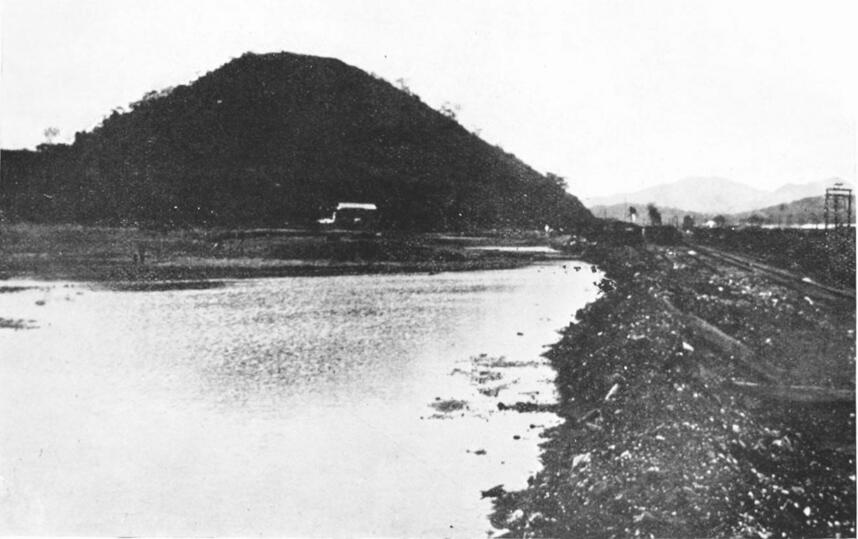
We then visited the dispensary, the commissary, and a kitchen and barracks, seeing on our way some water with the “iron rust” parasite. The labour force consists of Europeans, namely, Spaniards, who get 20 cents (gold) an hour, and of West Indian negroes, who get 10 cents (gold). They live in mosquito-proof quarters constructed of wood, and raised about 3 feet off the ground. The roof of each house is galvanized iron. It has no wooden ceiling, but has a jack roof, which is screened. Any spaces are caulked with oakum mixed with white lead, to prevent rats eating the oakum.
The “standee” bunks consist of an iron frame on which canvas is stretched. Periodically the frame and canvas are boiled, and the supports scorched, to kill bugs. But private clothing which is full of bugs is not disinfected, since the men strongly object to it. There are a few quarters subdivided for married men; but married men are not encouraged, with far-reaching consequences, of which we learn later on. Close by we saw the disinfection of the bunks carried out; they are boiled in an iron tank; the canvas is then scrubbed white, and dried in the sun.
| 10.2 |
Gatun |
17th May 1913. To Gatun by the 6.50 a.m. train with Major Noble, in the hospital car which is attached to each train. At the station Mr Corrigan, the sanitary inspector of Gatun, met us; and as we left it I saw, for the first time, a species of ant that cuts up the leaves of plants into small pieces rather larger than confetti, and walks off with them to its nest. Later in the day I saw a tree completely stripped of its leaves, and the surrounding ground was covered with the ant tracks and burrows. It was some time later before I learned that this ant had been, strange as it may appear at first sight, largely responsible for the high death rate from yellow fever among the higher French officials. The explanation is, however, quite simple. To protect plants in their gardens from the ant, people had placed a “moat” round each shrub. The “moat” is a double collar, made of the same material as ordinary flowerpots, and filled with water; and a well-kept garden with these moats round every shrub is a very curious sight. The moat was, of course, an ideal breeding place for the Stegomyia; and the larger the garden the greater the number of breeding places. So it came about that the higher officials, who naturally had the finer and more carefully cultivated gardens as well as the most numerous rainwater tanks, lived where the yellow fever mosquito was most abundant.
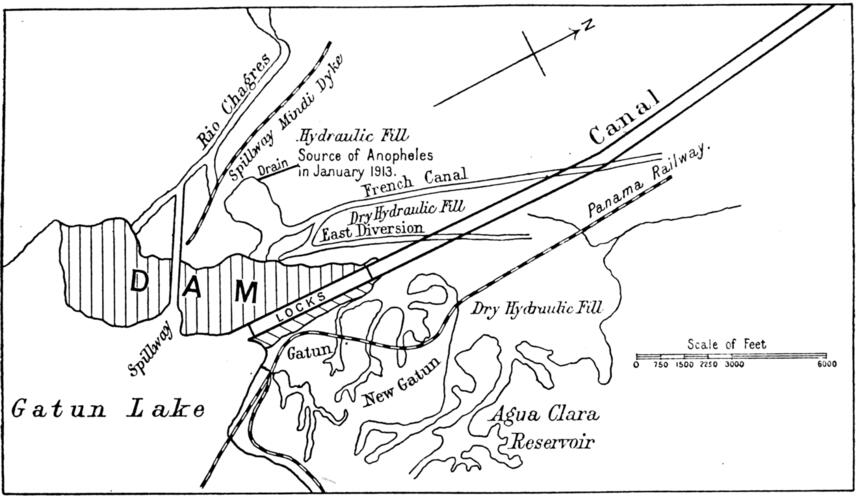
Crossing the docks on one of the great gates, I was fortunate enough to see an emergency gate in position, with some of its girders down. Then we visited a swamp where the open drains were being sprayed. Some of the drains were not more than 6 inches deep. Taking a boat, we made our way down the east diversion to the French Canal, which we followed up towards the dam. Then we entered a large basin, which had been excavated by the suction dredgers in filling the great dam with its hydraulic watertight core. When we entered the basin we saw fish jumping, and as we drew towards the corner where we were to land, the fish were in shoals. Our objective was a breeding place, the formation of which had produced an enormous swarm of Anopheles in Gatun town, which is a mile away. Some idea of the swarm will be obtained from the fact that the catch of Anopheles in houses rose from 149 in the week ending 26th October 1911, to 22,988 in the week ending 18th January 1912.
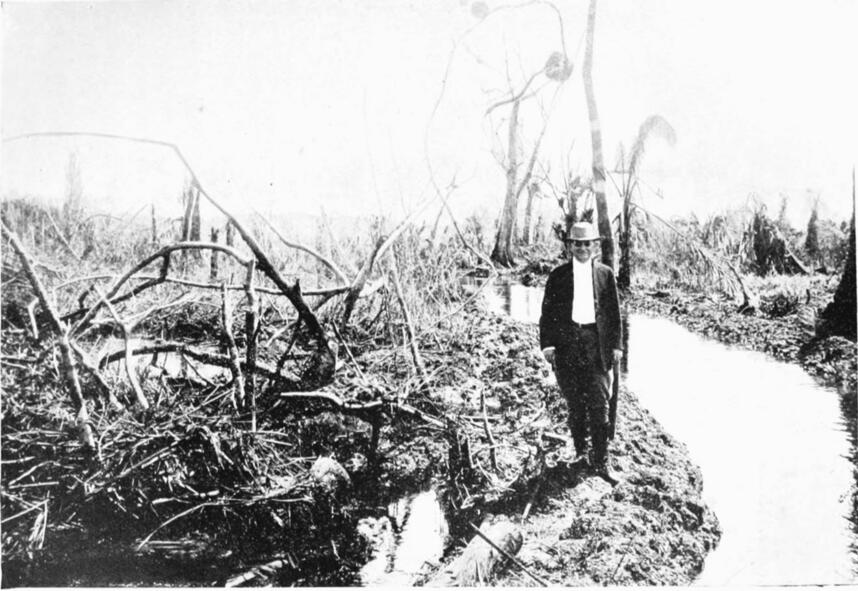
The swarm came from a swamp created by a suction dredger which, employed in deepening the Canal, had poured salt water and silt into an area of freshwater jungle. The immediate effect of the salt water was to kill off the trees and all vegetation. The silt was deposited, and raised the land; while the salt water, more or less diluted from the fresh water in the jungle, ran off by a drain at the end of which we had landed. The dead and dying timber produced by this “hydraulicing” apparently provided abundant food for Anopheles albimanus (A. tarsimaculatus, a subspecies), and also for the fish, which swarmed at the end of the exit drain. I have never seen a greater number of fish together. They varied in size from 3 feet long to tiny sprats. They jumped, and splashed, and dashed up the drain, only to be driven back by its strong current. In every eddy and corner there was a black mass of the smaller fish. A number of tortoises were also seen on the banks, and some in the water. Evidently the end of the drain was a splendid feeding ground.
Walking up it for about 300 yards, with beautiful fresh green jungle on our left, we suddenly came to a drain across our course, on the other side of which the trees were dead and leafless—a picture of desolation. Anopheles larvae were easily found in the brown dead grass at the side of the lateral drains, although I was told they were not nearly so numerous as they had been. I was struck with the number of small fish in the water, and at one place where the lateral drain narrowed to a passage of about a foot wide and 2 inches deep, I estimated the fish were passing at the rate of four or five a second. Yet within a yard of this constriction we got from three to twelve Anopheles larvae at each dip among the dead grass. There was practically no current in these lateral drains. The protection afforded by the grass did not seem sufficient to prevent fish with any enterprise securing the larvae had they been so inclined. Many of the fish were as small as the “millions.”
Farther on we stopped in some rather small open secondary jungle, but were not attacked by Anopheles. A few months before they had been swarming here, and in hundreds attacked people. Then we passed into an open space in which were holes produced by the blasting of tree stumps, in the preparation of the ground for the suction dredgers. Anopheles larvae were abundant in the green algae of these pools. Leaving this we struck through some small jungle, wading in the mud over the boots; and here Major Noble was attacked by an A. albimanus. Then we got on to the rather sandy bank of the French Canal (sandy because it had come from dredging the old canal), and made our way towards the place where the dredgers in the American Canal were discharging their silt. Here the mud and salt water were so concentrated that there was no food for larvae, and none were found. Crossing the French Canal, we landed on its east bank, and saw what had been an hydraulic fill. It was an excellent piece of land, with just sufficient sand in the mixture to prevent the sun-cracks which occur when pure mud dries.
Returning to Gatun, we visited a Y.M.C.A. After a much-needed wash, we dried ourselves with a “sanitary towel,” which consisted of a tough blotting-paper torn from a roll. Then we went to the “hotel” which belongs to the Canal authorities, where we had lunch, consisting of soup, steak pie, and the inevitable ice cream. The lunch was served in excellent condition, although we arrived at two o’clock, the end of the meal hour. On the table was a pink-coloured quinine mixture, containing 5 grains of quinine to the ounce of water. It also contained a little alcohol.
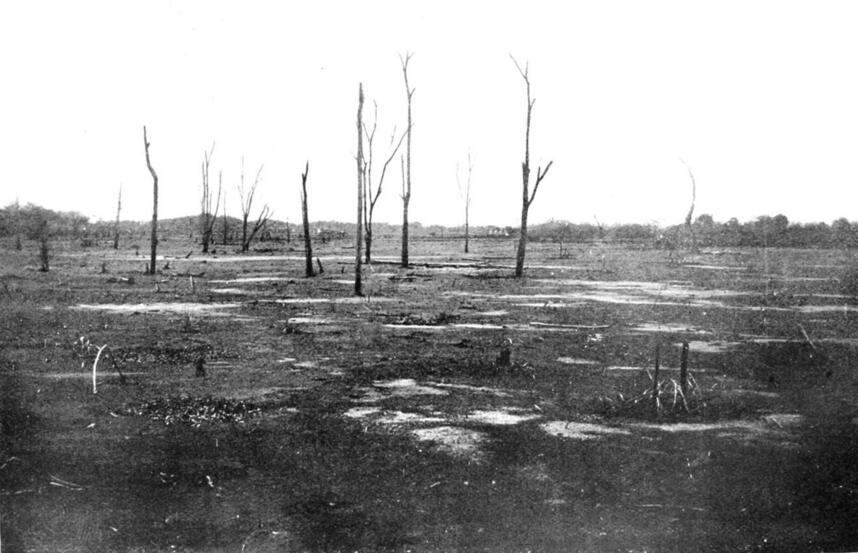
After lunch we visited a ravine in which pipes were being relaid, because they had ceased to act properly. This was due partly to the roots of a certain coarse grass having gained entrance, and partly to the kind of stone that had been placed on them. These pipes had been down six years, and had been covered with stone from the Culebra Cut. This, as we have seen, is compressed volcanic ash, which weathers quickly, in fact becomes almost liquid when in contact with water, and when dried again forms an impervious black layer. It had acted, indeed, like cement, and had sealed the subsoil pipes so that water could not enter them. Even the soil here becomes almost impervious to water. So now a different stone is placed around the pipes and over them until above ground level. No earth is placed over them, nor is grass allowed to grow over them. At places I saw pipes only about 18 inches below the ground, and some of the lateral drains were not 6 inches below the surface. This appears to me too superficial, and perhaps is from a wish to economise in stone. If deeper, it seemed to me they would not silt so easily; but, as I learned later, this fear is unfounded; nor would grass roots enter so easily.
But I am chary of dogmatising, for the local conditions are evidently very different from what we have in the Federated Malay States. I was struck with this within the first hour I was at Ancon. For on my way up to the Administration building the path crosses a ravine in the bottom of which there was an open drain very similar to that shown in Figure 11.2, from the “Drainage at Kuala Lumpur.” In Kuala Lumpur this form of drain was found suitable only where the grade was less than 1 percent; for at a higher grade the storm-water tore away the friable sandy soil from its sides, and the drain soon stood isolated in the air with the water flowing outside. In Ancon, however, with a grade of fully 15 percent, the drain was in perfect order with the grass growing on each side and the soil undisturbed. The difference was due to the red volcanic soil (locally known as gumbo) being very adhesive when wet, and not liable to scour like the light sandy soil in the ravines of the Federated Malay States.
There is practically no sand in the Canal zone; that required for concrete is brought in lighters from various parts of the coast. It was the same adhesive volcanic soil that I had seen in Sumatra and in Hawaii. From this peculiarity in the soil a very cheap form of drain has been found practicable. It had been first employed by one of the inspectors. The place to be treated is drained in the usual way; then a length of chicken wire is placed in it, and covered with a mixture of sand, gravel, and cement. Here and there, especially at bends, the drain is “keyed” into the sides. This form of drain has the advantage of permanency and cheapness, for in many places it can be put down for 5 cents a foot, which is much less than the cost of subsoil piping. At the first place in Gatun where I saw the drain, the fall had not been utilised, and the drain was not running well; but further on in New Gatun I saw a good example of it in the bottom of a ravine that in times of storm must carry a great volume of water. In the ravine there was a ditch about 6 feet wide at the top, and 4 feet deep. In the bottom, which was 2 feet wide, there was a shallow “wire” drain, just sufficient to carry the ordinary flow of water. In a storm there must be at least 4 feet of water tearing down the ravine; yet the drain was in perfect condition, and the banks showed no signs of erosion.
Walking along the railway, we saw an old French locomotive boiler doing duty as a Sanitary Department oil tank. It is filled from a train that carries oil especially for such tanks.
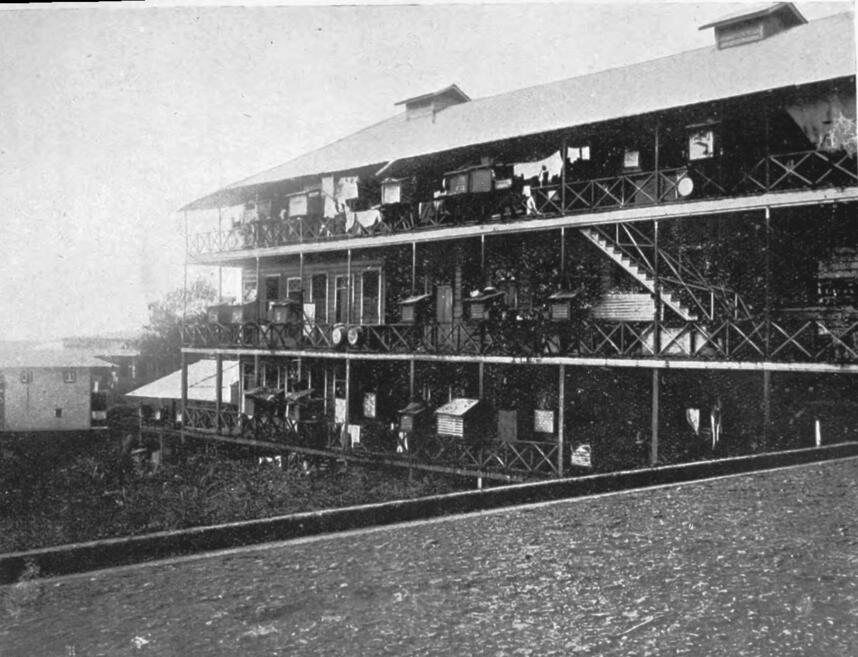
In New Gatun—the native (or negro) quarter of this station—the houses are not screened. They have been built by private individuals; and as the rents are high, they are good investments, so I am told. The houses are divided into single rooms. Each tenement must, by law, have a sink, a water-closet, and a bath, connected with the sewage system, and properly trapped. The standard of cleanliness was no higher than I expected, but the water-closet is a clearly marked improvement on any possible system of dry conservancy, even for the negro. Cooking is done in a little box suspended over the verandah. All houses must have the proper number of dustbins, which are supplied and emptied by the Quartermaster’s Department on behalf of, and at the expense of, the Sanitary Department. To prevent rat-breeding, the floor of the house must be cement, unless raised on an average of 3 feet from the ground. The walls must be of a single plank; or if double, the space in the lower foot must be filled with cement. Double walls, ceilings, and everything that provides hiding and breeding places for rats are discouraged.
Leaving the houses and the ravine with the wire drain previously described, we reached one of the filter stations of the Colon water supply. The water is heavily charged with vegetable organic matter, and alum is used to precipitate some of this. Four sand filters are housed in quite a small building. Attached is a small laboratory, where bacteriological and chemical analysis of the water is carried out. The filters have to be washed every fifteen hours, on account of the heavy silt, even after the precipitation. The bacteriological analyses were not very satisfactory at the time of my visit, the reduction of bacteria being only from 1000 to 250. This is probably due to no water being run to waste after the washing.
From the filter-beds we went up a ravine in which the water ran in a channel cut in a soft yellow sandstone composed of very fine sand particles embedded in a mud matrix. This small outcrop is evidently the origin of the sand seen in the swamp. The stone was soft enough to be cut with a pick. In many places small lateral channels had been cut, connecting springs on the earth sides of the ravine with the main channel. At places the stone was bare for 10 or 15 feet in a slope up the side of the ravine, and down this, small channels were cut for water oozing out at the top of the slope. In all the small channels, a piece of waste soaked in oil was anchored. Potholes innumerable had been filled up with stone and cemented over. We followed up this ravine for a considerable distance, and I must express my admiration for the excellence of the work and the intelligence and thoroughness with which it had been done.
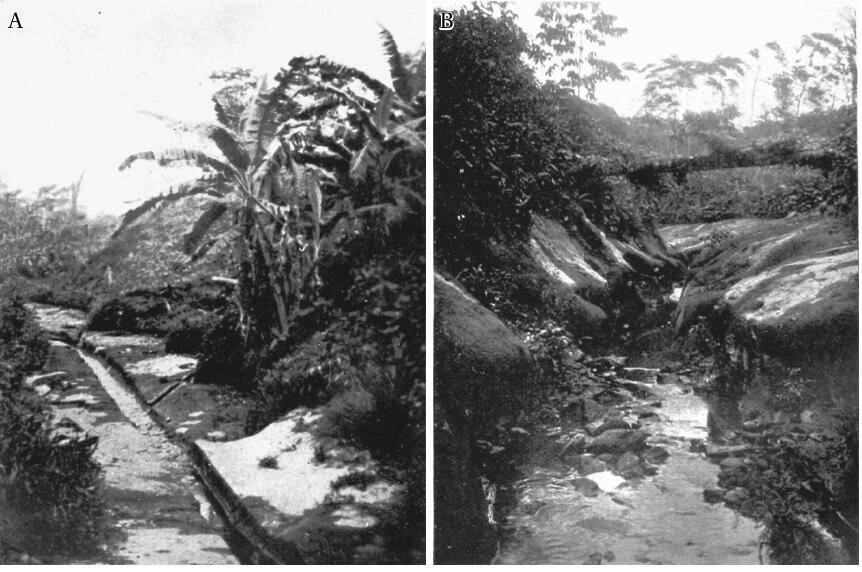
Originally these ravines had been filled to a depth of nearly 10 feet with broken-down vegetable matter; and it was only when this had been cleared out that the inspector had come to the sandstone. Even then the channel was very irregular, and a good deal of work was required to convert the water-worn channel seen in Figure 10.8B into the excellent result seen in panel A of the same figure.
Gatun has a permanent system of drainage unlike most other stations; for it has never been used as a “dump.” It will always be important, too, as the site of three locks. The excellence and thoroughness of the work did not, however, depend on these circumstances; for at every station, whether permanent or temporary, whether the conditions were favourable to or difficult for the inspector, I saw the same intelligent care in the sanitation. Men evidently worked with brains on the Canal zone.
| 10.2.1 |
A Sanitary Inspector’s Office |
Returning to Gatun, we visited the sanitary inspector’s office. Prominently on the wall was a chart showing the weekly malaria rate for the station for the past three years. It was one of the duties of the inspector to keep this chart up to date, so that the health of the station can be seen at a glance. In addition, he has plans of the whole station, showing the drainage systems and the grass-cutting plots. Every drain and its lateral of each system is marked in a uniform way. The systems are A, B, C, D, and E. The lateral drains are 2, 4, 6, 8; the even numbers on the right hand going up; and 1, 3, 5, 7, etc., the odd numbers on the left. In a table on the plan is shown the kind of ditch, and the [length of the ditch in] number of feet.
The plan of the grass plots gives the area of each plot. The work of cutting grass is no longer done by the Sanitary Department, but by the Quartermaster’s Department on requisition by the sanitary inspector, who sends in his requisitions on Monday mornings, stating the number of plots, the number of square yards, the estimated cost, and whether to be done by horse-mower or scythe-men. The cost of the work is charged to the Sanitary Department.
| 10.3 |
Miraflores |
Monday, 19th May. By the 6.50 train to Miraflores, where I was met by Mr Shrimpton, the sanitary inspector. Near to his office we saw a well-burnt ditch. Oil is sprayed among the grass roots on the side of the ditch, and burned at the same time. The grass is almost killed, while on the surface of the ground a deposit of heavy asphalt takes place, which delays the reappearance of the vegetation. Although it does not entirely kill out the grass, it is certainly very effective in checking its growth. On some ditches asphalt was so thick that the side looked like an asphalt path. This can have required treatment only once in six months, and represented a great saving in grass-cutting.
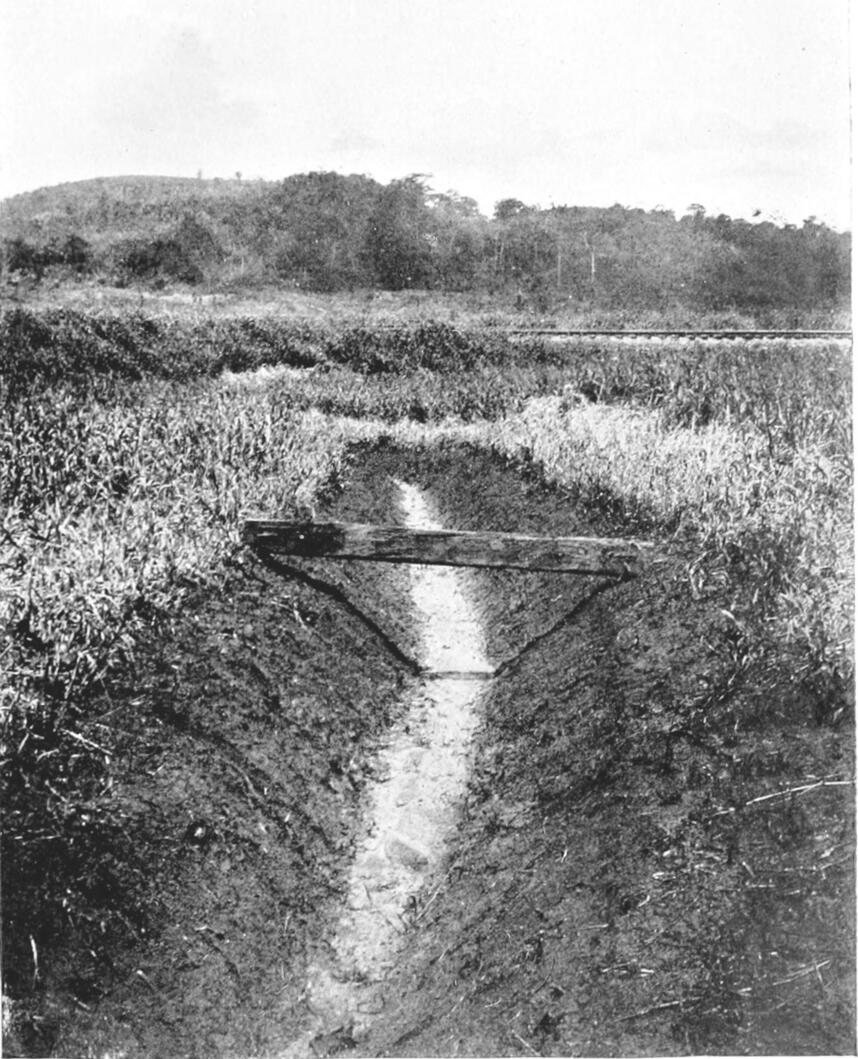
Walking over what will soon be the bottom of the Miraflores Lake, we saw men clearing away jungle and scrub at contour level 55. This is to prevent much dead timber being formed when the lake is filled; for such timber forms a breeding ground for Anopheles. If the edges of the lake are free from timber, wave action will be sufficient to prevent Anopheles breeding along the shores, and the danger of ships becoming infected with malaria during their passage through the canal will thus be greatly diminished.
Ascending the dry bed of the Cocoli River, which had been dammed and diverted to form a temporary and auxiliary water supply for Panama City, we came to some rock pools. Numerous Culex larvae were present in some of them. The pools had been oiled some days before, and the larvae were young. The inspector had found Anopheles larvae in them about a week before, but we found none at the time of my visit. Climbing over the spill way, we examined the side of the reservoir without finding anything. When it had been first filled, it had supplied a swarm of Anophelesalmost as great as that at Gatun. It was not intended originally to use this as a drinking supply, and so the vegetation had not been cleared away; indeed some small dead trees were still standing. The dead timber had supplied the necessary food, and Miraflores was inundated with the insects. As many as 11,343 had been caught in a week. In the week prior to my visit five men had caught 354 Anophelesin seventeen houses and six cars.
Coming back by the lock, we found a few small larvae in a trickle of water overgrown by grass. Then we visited a large swamp partly natural, but mainly caused by the engineers having held up the waters of the Rio Grande for a fortnight. They required the water to fill a portion of the Canal before they could blow up the dam that kept out the Pacific Ocean. In Mr Bishop’s book a very good photograph of the explosion is shown; 16 tons of dynamite were let off at one charge.
In the swamp we found no larvae. An oil-boat is used on this swamp; for it is the only means of reaching many of the grassy patches where larvae are found at times. Crossing the line we reached the East Miraflores “dump.” It looked about 20 feet high, and was half a mile square in area. The surface was dry, but from the bottom layers water poured out. Heavy rain had washed a good deal of the soil from the dump into the ditch cut along it, and the drainage channel was completely obliterated. As a consequence there was a swampy patch in which we found Anopheles larvae.
Making our way through some scrub, we came to a small clear stream, which we followed up for some distance, without, however, finding larvae. In the pools were many small fish; but there was plenty of cover for larvae, certainly as much as in the swamp at Gatun. This stream is outside of the area under routine treatment. Returning to the railway station, we then struck up the Camatillo River, ultimately to be a branch of the Miraflores Lake, and followed a small subsidiary stream to its source, where among the grass we found a few Anopheles larvae. Our way back was along the Camatillo, which, having been partly dammed by the new wagon road from Panama to Gorgona, had created an extensive swamp. It had been thoroughly oiled, and was free from larvae. At this point (see Figure 10.10) I met a negro with a bottleful of large Anopheleslarvae, which he had collected for Dr Darling from beyond the oiled area.
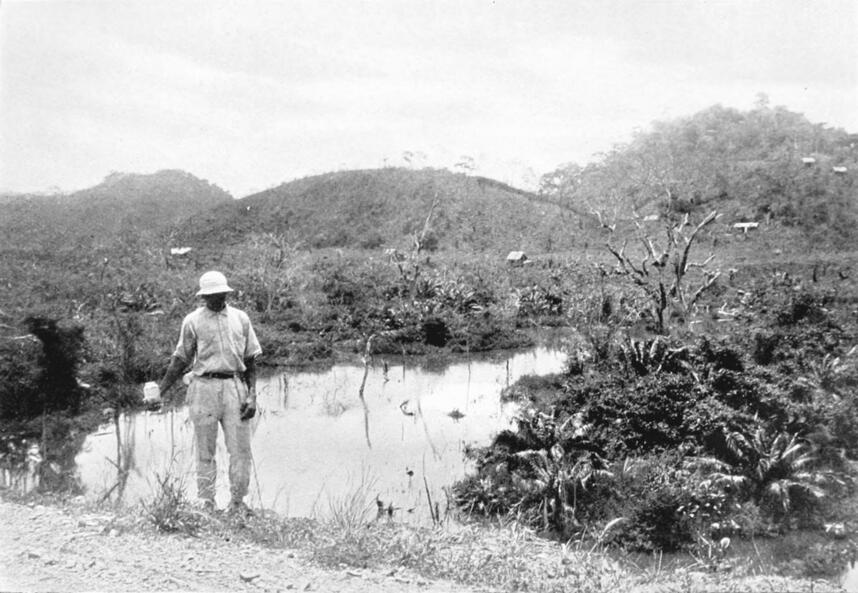
At Miraflores the sprayers use the following mixture: larvicide; 1 gallon; water, 3 gallons; crude oil, 8 gallons. The oil is added last. Mr Shrimpton considers the addition of water an improvement on a mixture of only the larvicide and crude oil. In a month in this station they use from 4000 to 9000 gallons of crude oil, and from 1000 to 2000 gallons of larvicide; the amount depends on the season and the area to be oiled. The area may be greatly extended when for some special purpose the engineers dam up a river or stream. At the time of my visit, many acres of swamp had been created by the damming of the Rio Grande, and this required a large additional expenditure on oil.
| 10.4 |
Gorgona |
Tuesday, 20th May 1913. By the 6.50 train to Gorgona with Mr Bath, divisional inspector. At the station we were met by Mr Park, the sanitary inspector, who took us to the condensing station. At many of the stations on the Canal condensed water in bottles is delivered to the houses by hand, while raw water is supplied through the pipes. This is more economical than putting down filter plants for stations which will be abandoned ultimately. Gorgona will soon have to be abandoned, because it will be covered by the waters of Lake Gatun.
At the reservoir we found coolies cutting the grass that grew between the stones facing the dam; and in some grass debris we found Anopheles larvae. The water in the reservoir was low at this time, and ground usually submerged was covered by a yellow thallus about one inch high. In this no larvae were found; nor were they ever found in it, so Mr Bath told me, because no dead vegetable matter is found here. Nor is long grass per se dangerous; but it may become dangerous if it retains debris to which fish cannot gain access. Larvae are almost certainly found when fine pieces of wood have been in water long enough to become covered by a fine “furry growth.” This growth seems to be both a food and a cover for larvae.
Paddling across the lake, we came to a stream which came down from the jungle, but which before entering the lake had lost itself in a bank of sand. Cut off from the lake, and imprisoned in the stream, were thousands of little fish about twice the size of “millions.” A few were dead, and the remainder were reduced to a minimum of water, and in great danger of death. They formed almost a solid mass. Following up the stream we found a few larvae in shady side-pools, especially among some masses of whitish roots. They bred out as A. malefactor, a mosquito which does not carry malaria. Mr Bath told me before we went there he did not expect to get A. albimanus. Returning to the lake, we went to another and larger stream with a considerable current. It was full of grass, and in Malaya I would have expected A. albirostris, but no larvae were found, and Mr Bath told me A. albimanus could not live in such a stream. Clearly A. albimanus is not a stream-breeder like A. maculatus, or even like A. albirostris.
Then to another stream where the current was almost absent in the wider portions of the channel. Algae had grown here, so the inspector told us; but he had drawn 5 lbs. of copper sulphate in a bag a few times up and down the stream, and destroyed them, so no larvae were found. Copper sulphate is used in the reservoirs whenever algae threaten to grow. I was not surprised to hear, a few days later, that Mr Bath had returned to the reservoir and lifted the imprisoned fish back into it; nor that, improvising a sifter with his handkerchief, he had removed all debris left by the grass-cutters we met on the dam, and every larva with it. To some this may appear meticulous care; yet it is just this thoroughness which has made the construction of the Canal possible. Mosquitoes may be small, but they are formidable opponents, ever ready to find the weak spot in the human attack or defence. Those who know this enemy best are the most wary; while many a fine champion has bitten the dust by neglect of small and apparently unimportant precautions.
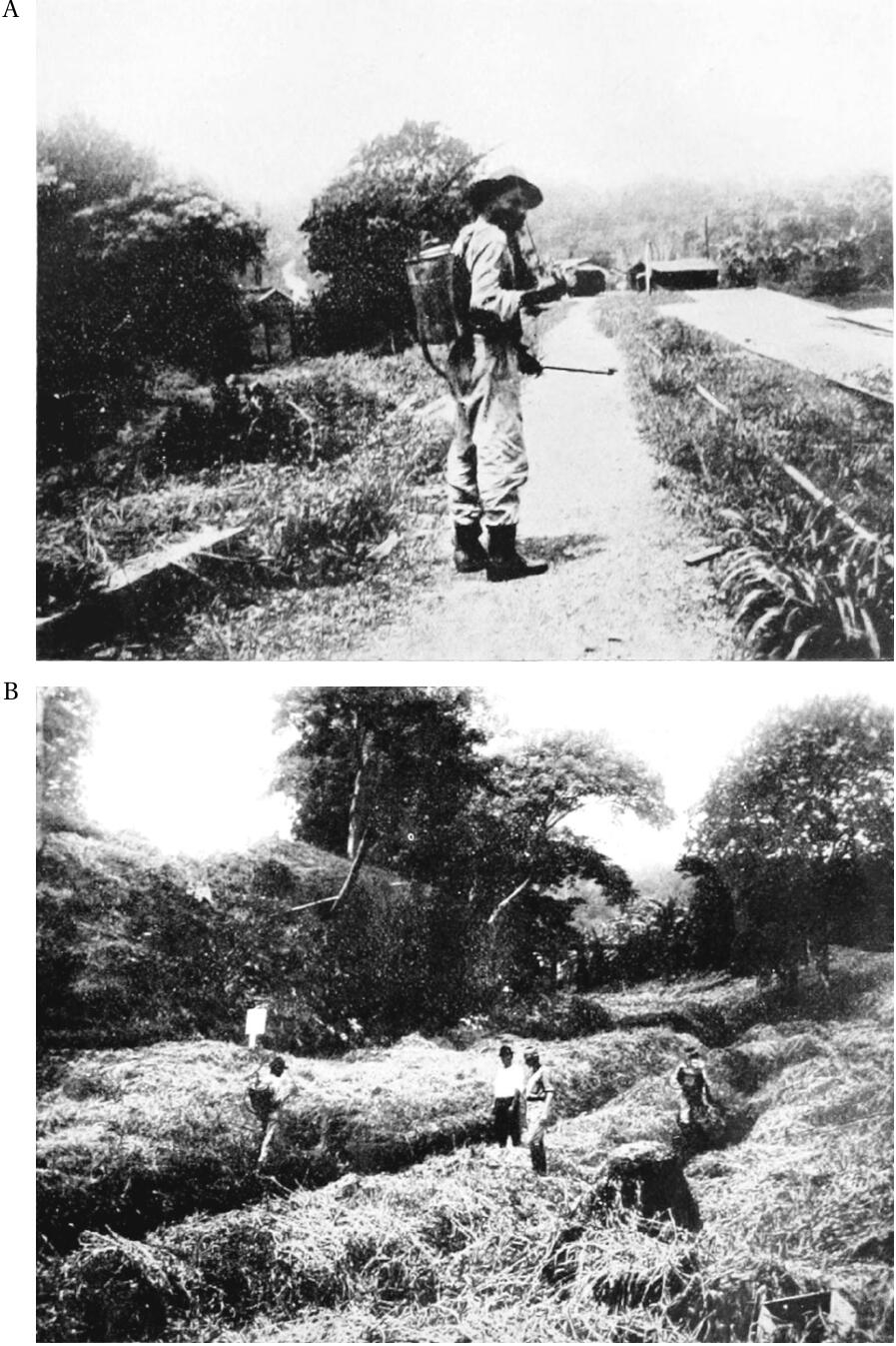
Half a mile from the town are the slaughterhouses, and beyond these were deep shady pools, the home of A. malefactor. With the rising of the lake water these pools have become very extensive; and although Mr Bath expected to find some larvae, none were captured, because recently the area oiled had been extended to these pools, and the oiling had been thoroughly done. When coming back I noted that, as in other stations, the houses in the native quarter were not screened. Near to the railway depot we saw the Sanitary Department oil tanks, which are connected with the trans-isthmian 8-inch main [oil pipeline]. The photographs of the man with oil-sprayers, and of sprayers at work on ditches in a swamp (see Figure 10.11), were taken here. The stream and side ditches were as black as pitch after the oil had been applied.
| Anopheles | 37 | 37 | 20 | 41 |
| Culex | 91 | 94 | 188 | 345 |
| Stegomyia | 35 | 0 | 0 | 0 |
The following table gives the number of mosquitoes caught at Gorgona in the preceding four weeks:
| 10.5 |
Matachin |
After lunch at the hotel we walked to Matachin, the next station to Gorgona, on the way finding a few Anopheles larvae, but no pupae, in a recent pool in a railway cutting. Larvae are often found in pools five or six days after oiling; but they never pass beyond the larval stage, for they are killed by the next oiling. The Manual says: “The finding of pupae in a sanitary district will be considered as neglect on the part of the Inspector.” In a climate with such a heavy rainfall, in a country covered with vegetation so dense, and in a place where the surface is so liable to be altered by the engineers, it shows an extraordinary degree of thoroughness that such a rule could be made. During my visit I examined pools for mosquitoes in every part of the zone, and I can bear witness to the fact, that although larvae were, as I record, occasionally found, on no occasion did I find pupae within a sanitary area.
Between Gorgona and Matachin we passed many earth-drains, all properly oiled. Just above Matachin railway station there is an extensive swamp, caused by the collapse of a culvert under the railway. At the time of my visit the culvert was completely blocked, and men were digging at the lower end of the culvert to clear it; and the water level in the swamp was rising rapidly on account of the rains. From time to time the water bursts through the culvert. I was struck by a remark made by the inspector here, on the difference this made in the breeding places in the swamp. The remark was made quite casually, but it was evidence of the care with which the subject had been studied that, to this inspector, his remark should be a commonplace.
The swamp was being oiled from a punt. On the lower side of the railway there was another extensive swamp, again due to interference with drainage by a “dump.” The box culvert had collapsed and an overflow had been cut, but it was too high for proper drainage. This station will be abandoned shortly, as both it and Gorgona will be covered by the waters of the Gatun Lake; in the meantime these extensive swamps, which could easily have been drained, require a heavy expenditure of oil.
During my visit to Panama I was never able to satisfy myself that from a distance I could recognise the smaller swamps and damp places by the vegetation alone, as I can in England and the Federated Malay States. In these countries patches of dark rushes and sedges, lighter or darker green, or bluish tinted grasses, mark out the wet ground of a swamp, or of a spring on a hillside, as if with a flag. In Panama there was nothing so distinctive, as far as I could see. One extensive swamp, near to Panama City, was so evenly covered by bright green rushes, that it looked like a rice field; and Major Noble pointed out a plant, whose name I have forgotten, as usually found where the ground is wet. It is known in Malay as “brakas,” and its leaves are used to shade young coffee plants. It often grows in brackish swamps. Beyond these there was nothing distinctive in Panama.
In Panama the ground is covered mainly by three species of grass (in a non-botanical sense). The most widely spread is what is known as “cabaloté.” It is probably not a true grass. It is very prolific, has a coarse flat stem, breaks easily at the joints, from which it throws out roots, and has a thick fanlike head. It grows to a height of 4 or 5 feet in favourable places, such as this swamp at Matachin; but it also grows freely on dry soil. It is useless as fodder, and is the grass which finds its way into and blocks subsoil pipes; I have seen nothing like it in the Federated Malay States. I was warned there were deep holes in this swamp, and the inspector fell into one in crossing; but from the vegetation there was no guide to what was swamp and what was solid ground.
Para grass (Paniceum muticum), on the other hand, is an excellent fodder. In appearance it is much like Guinea grass, but it does not grow in clumps like the latter. Para grass is very abundant on the zone; Guinea grass, though common, is much less so. Bermuda grass is a short fine grass, excellent for lawns. It is imported, and is planted on the savannas for cattle-grazing. In the Federated Malay States the coarse grass lalang, which displaces practically all other vegetation in open spaces, dies out when constantly mown, and is replaced by some of the short surface-feeding grasses. But in Panama nothing analogous to this takes place, and the scythemen have always to contend with these strong, coarse grasses. It would perhaps be an advantage to Panama if some of our short grasses were introduced: the cost of the upkeep of the grass areas would perhaps be reduced.
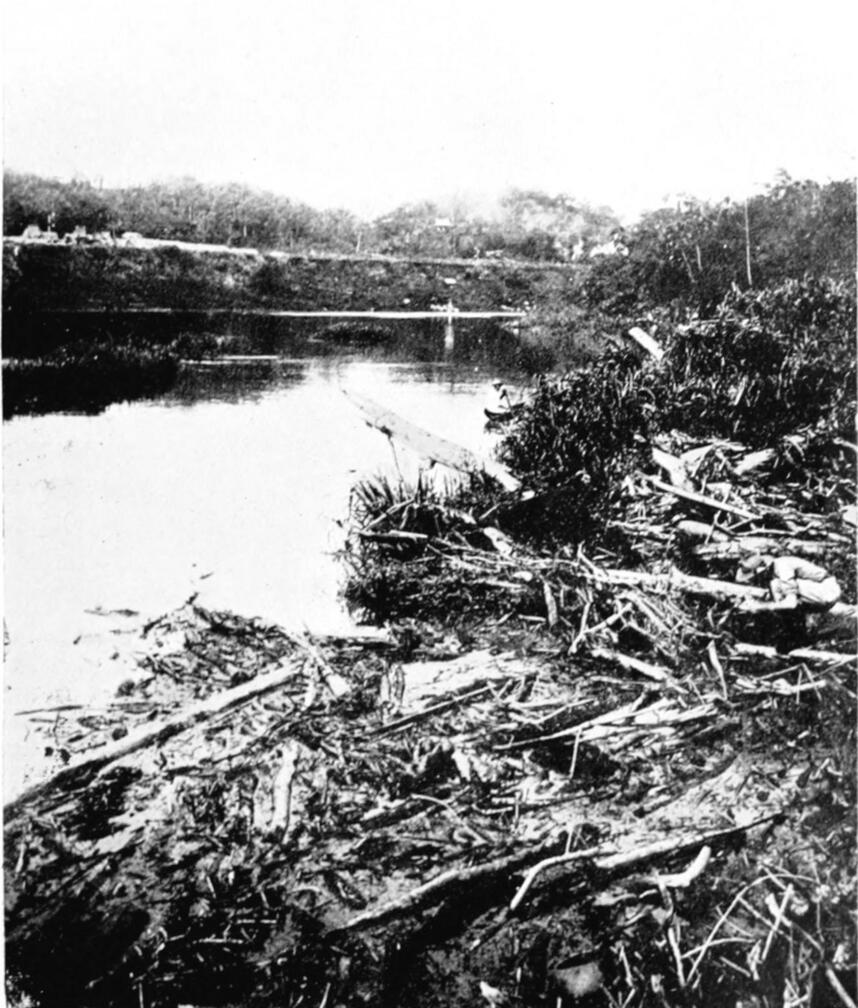
On the following day (21st) we (Mr Bath and myself) returned to Matachin and took a boat on the Chagres River. As the Gatun Lake was now being filled, the river was much above its original level, and was continually rising. It had consequently flooded what had been dry land, covered with grass. Mr Bath had visited a stretch of the river opposite Matachin a few days previously, without finding larvae in the grassy banks. Despite a careful search, we only found one small Anopheles larva in the grass. But in driftwood in an eddy farther up, we found a considerable number of larvae, showing again the predilection of A. albimanus for dead wood. While paddling along, Mr Bath showed me what he called “seaweed” grass. It consists of a long stem, from every few inches of which radiating rays break out. When crushed in the hand, it has a strong garlic-like odour. He told me that he had never found larvae where this existed.
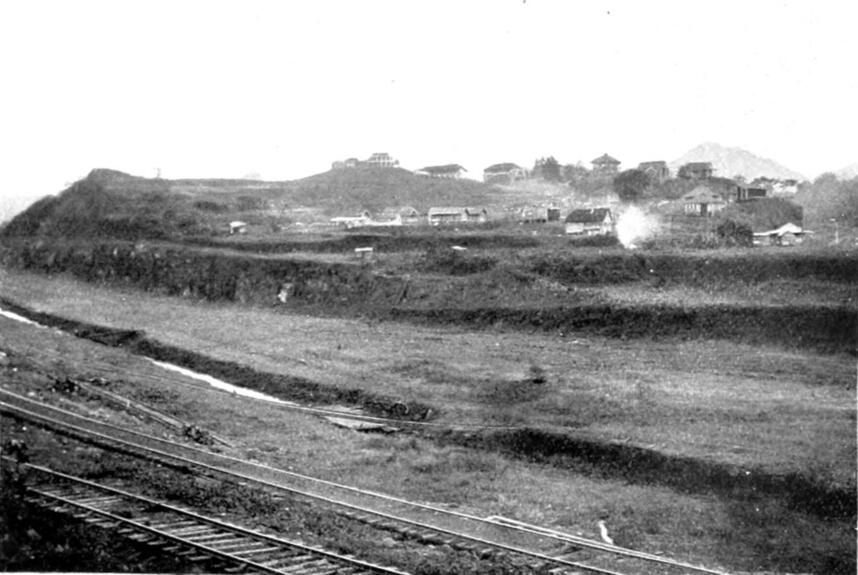
Landing on the Gambon dyke, which keeps the Chagres from flooding the Cut, we dropped into the Cut and walked along it for about a mile. In the centre of the Cut is a 20-feet wide drain, which keeps the bottom fairly dry, but in many places there are breeding pools, all of which are oiled weekly. To facilitate this, oil pipes have been carried to the bottom of the Cut at certain places. In places the bottom of the Canal is like a mosaic of stones loosely set, between which are little pools of water. These are prolific breeding places for Anopheles, and not the least important part of the inspector’s work is supervision of these countless isolated small pools. At the sides of the Cut, innumerable small springs exude, each of which must also be oiled. When we consider that this Cut is 9 miles long, that at the south end the sides are terraced to a height of 400 feet, and are constantly being altered in the excavations, some idea will be gained of the magnitude of the sanitary work done. The Cut is a special danger; for a series of stations containing thousands of people have been built on its banks, well within the range of mosquitoes breeding in it.
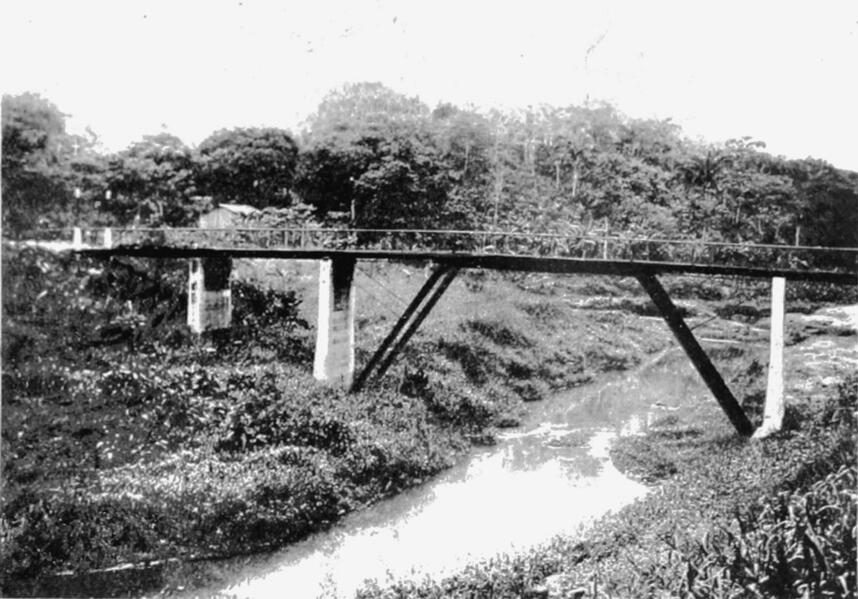
Climbing out of the Cut at Haut Obispo, we walked to Bas Obispo, past Camp Elliot, and had tiffin at the hotel. Through Bas Obispo runs the Rio Mandingo, which, with its tributary the Camacho (both more or less artificial now), drains the land on the west of the Canal into the Gatun Lake; it is a stream about 20 feet wide. At the time of my visit, the rains swelled it occasionally to many feet (6 to 10) above its ordinary level, and washed all larvae away. It was, therefore, not oiled at the time, nor were its larger tributaries. But while in wet weather there is this saving of oil, more oil is required for pools and springs which appear elsewhere; so that what is saved in one direction is lost in another. To put it another way, A. albimanus flits from one kind of pool to another according to the season. In dry weather it lives in pools in stream beds, and makes its way on to high ground. But in wet weather it is washed out of these, and lives in pools formed in low swampy ground, and in the springs formed on hillsides by the rain. All this is known in Panama, and the sanitary inspectors alter their tactics accordingly.
After tiffin at the hotel, where I asked for, but could not obtain, quinine, we took train to the next station, Las Cascadas; and I was interested to see that in the town they had the combination of a pipe drain below an open cement drain, which we have used at Port Swettenham, and which seems to me to have so many advantages for towns. In the ravine behind the houses we saw a tile drain covered by stones. At one place it was evidently blocked, for the water was welling out, only, however, to disappear within the next 10 feet. Lower down this ravine, where the drain was open, there were several side streams, all of which have small barrels dripping oil. One barrel in particular attracted my attention, or rather the cutting away of the scrub attracted my attention to the barrel. It was about 20 feet from the ditch, and about 10 feet above it. Only a careful examination of the bank of the ditch could have led to the detection of this spring, and it was another indication of the “brains” used in doing the sanitary work.
From Las Cascadas we walked a couple of miles to Empire, passing Camp Otis on the way. The whole length between the two stations was oiled. In passing we visited a field where formerly, in cattle hoofmarks, Anopheles had been found; but the marks of the cattle did not contain water at the time of my visit. There we met what looked like a water cart, with a long pipe projecting out on one side. It sprinkled oil in the roadside ditches, not water on the road, and was the invention of Mr Trask, one of the inspectors. The flow of oil is controlled by a valve at the driver’s hand, and the pipe can be raised or lowered by a foot-pedal.
| 10.6 |
Empire |
As we entered “Empire” we met a Stegomyia gang. “Stegomyia Day” is held once a week, and the gang then visit every house. I saw two large collections of old bottles and tins, etc., on the side of the road, awaiting removal. All these years of sanitation had quite failed to overcome the tendency of the negro to throw rubbish out of his house. Prosecutions are instituted only if the offender is caught in the act. If the presence of bottles and tins on a man’s premises were an offence, then most of that negro population would have been in court. Each of the men belonging to the gang was armed with a sharp-pointed iron rod about 3 feet long, with which he transfixed and lifted tins, or smashed bottles. Some inspectors insist on bottles being lifted, not smashed; because even when broken the bottom pieces may remain intact and constitute a danger. I confess I was rather struck by this scene. Here was anything but the military despotism and tyranny which I had heard of before coming to the zone; but it was quite in the spirit of all I had seen and heard of it.
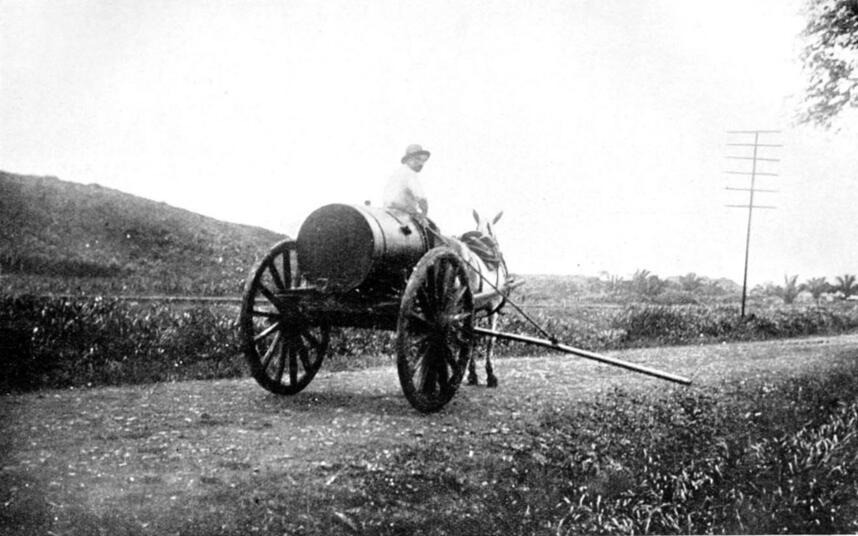
The Stegomyia is prohibited on the zone. The Manual says: “There must be no Aedes (Stegomyia) calopus breeding in the Canal zone.” Yet the inspectors had told me they only emptied tins or barrels, etc., containing rainwater. They did not smash them, because they found it made enemies of the people, and made their work more difficult. From what I saw in the zone, I am satisfied that the sanitary inspectors act in the spirit of the rule of their Manual already quoted (see Section 9.3.2) and realise that “the advancement of sanitation is a matter of education rather than force.” The following rule states: “The aid of the police and judiciary should be invoked when ever necessary, but only—except in emergencies—after due warning has been given in writing, on the prescribed form. …”
I gathered, however, that the inspectors rarely went to court; and in 1912 the Annual Report for the Canal zone records 2671 notices, 200 arrests (i.e. summonses) for violation of sanitary regulations, and 181 convictions. Surely very small numbers, when we consider that the area is 50 square miles, that the population of 79,279 is composed mainly of negroes, and that on the zone the standard of sanitation is higher than is to be found elsewhere in the tropics, or, indeed, in most places out of the tropics. This is a complete answer, in my opinion, to the statements that sanitation in Panama is the result of putting inhabitants under military discipline.
The glee with which the following story was told me indicated, too, that the magistrates on the zone were, like most other magistrates, rather on the side of the accused than of the sanitary inspector. A negro baker had been charged with being drunk, and keeping his premises in a dirty condition. The magistrate held the charge not proven. The sanitary inspector asked if he might in the presence of the magistrate warn the prisoner to keep his place cleaner, to which the magistrate agreed; and the inspector began: “Now, Mr Sambo, I want to warn you that the next time you get drunk, and fall asleep with your dirty boots on the dough, I will run you in.” As the magistrate bought his bread from this baker, the inspector hoped he had given both prisoner and magistrate a warning.
Whether the story is apocryphal or not, I cannot say, but I took it as showing that the sanitary inspectors did not hold the magistrates in the hollow of their hands; and certainly there is no military discipline in Panama that I had heard of. The sanitarian in Panama, as elsewhere, had found the work was done quickest, most satisfactorily, and with least friction, when done by himself; and the less he asked people to do for themselves, the better. For the sanitarian this is the beginning of wisdom. The fact of the matter is, that the sanitarians in Panama are men of common sense and have a sound knowledge of human nature. They know that while a few men may be born poets, none are born sanitarians; and that the ordinary man finds sufficient employment for his time and thoughts in the ordinary struggle for existence, without having to bother about sanitation. And so, when the Department of Sanitation wants anything done, it does it for itself.
Empire is one of the best laid out stations on the zone. The houses are built on the gentle slopes of the hills. There are wide areas (463 acres) under grass, cut by a horse-mower; and there is a good permanent drainage system. Between the official quarter and New Empire, the negro section, runs a stream from the Camacho Lake, about 3 feet wide and 6 inches deep. It is not oiled, as the water has to be sterilised for drinking. Instead of oiling, the banks are “trained;” and this is found sufficient to prevent larvae from appearing. The “training" is done once a year, after the rains, and consists in taking the stones from the stream and placing them along the banks. During heavy rains they are displaced, so “training” is not done until the dry season has definitely set in. In wet weather the stream is harmless.
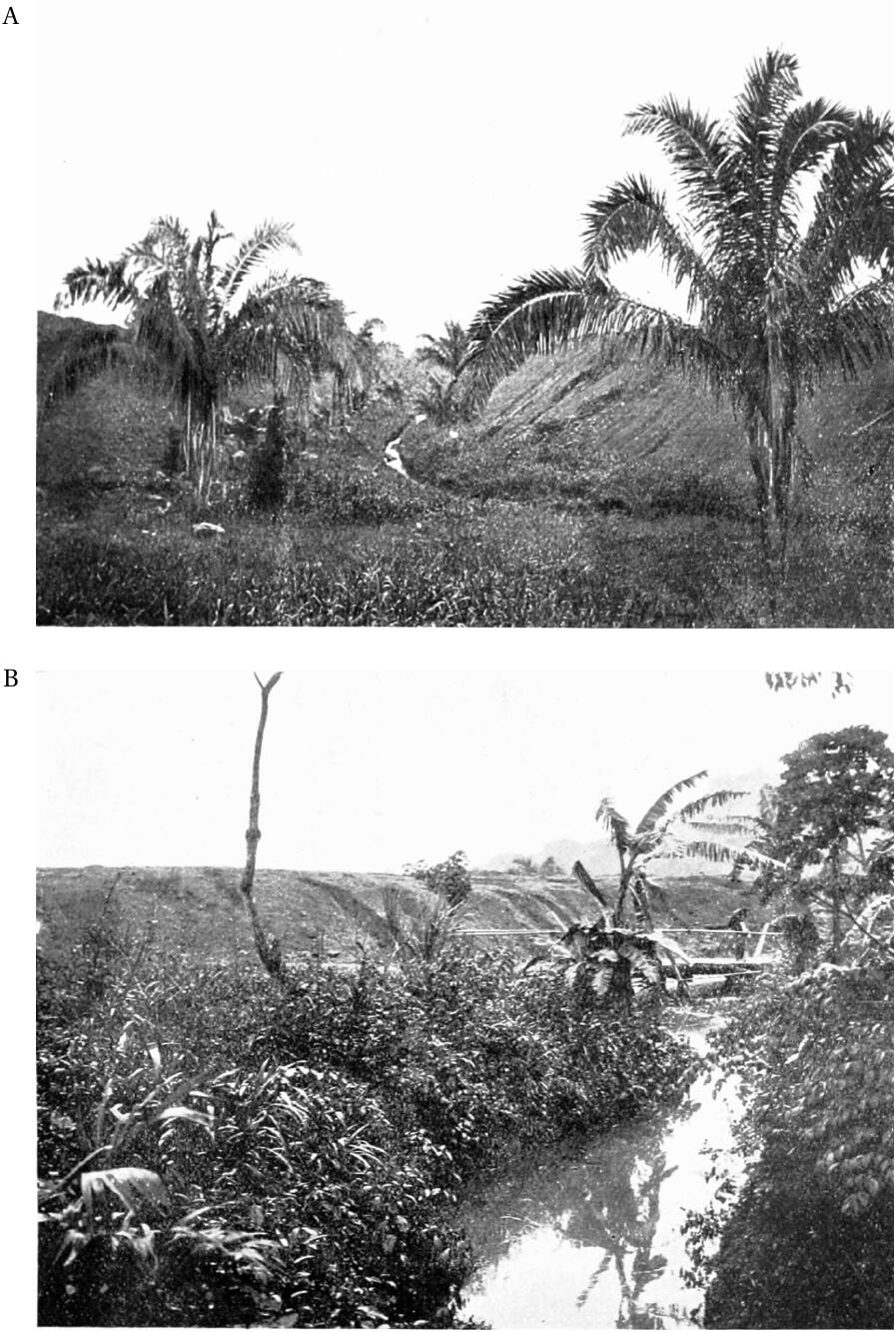
| 10.7 |
Culebra |
This station I did not visit until the the 28th; but as it adjoins Empire, I may as well describe it now. The Commission houses are on hills between the railway and the Cut. To the west of the railway there was formerly a swamp, but it has now been filled. All the filling had not been done at one time; and as the filling on each occasion had interfered with drainage, several systems of drainage had disappeared. Figure 10.16 shows the extent of the filling, and also how the filling has obstructed a stream.
On the side of this filling opposite to the Commission quarters is the native quarter entitled “Golden Green.” The houses are on the slope of a hill, the foot of which is carefully drained and oiled. This quarter is not connected with the sewage system, and there are a number of pit-closets about. There is also a “range closet,” in this instance a large cement tank from which the sewage is pumped. The odour from it is very offensive, and showed its great inferiority to the trough closets. It struck me as a “spot,” and one of the very few, in the Panama sun. There is a pipe water-supply.
At Washington I heard Colonel Gorgas tell his audience that there is one drawback to abolishing mosquitoes from a place, and it is that when one or two gain entrance into a house, the Sanitary Department receives a letter from an indignant household, to the effect that two mosquitoes had been seen, and that one had bitten him. I was not a little amused, therefore, when Mr Shropshire, the sanitary inspector with me, was stopped by a lady, who said she was so glad that she had met him, as she was just going to write to say her little girl, when playing below the house, had seen seven mosquitoes. Need I say Mr Shropshire politely intimated that the matter would receive immediate attention.
Yet this scene took place in a station where the conditions were specially favourable to the mosquito. To the east was the deepest portion of the Cut, which was here terraced to a height of 400 feet, with each terrace a mass of springs capable of breeding mosquitoes. Here, too, slides of thousands of tons of soil were constantly creating new pools, and all required increasing attention. That such a complaint as the above could be made, that such a scene was possible, is a proof of the thoroughness with which the anti-mosquito work had been carried out.
At Ancon my experience was the same. During my stay of nearly three weeks, I saw one mosquito in my room, and five outside. One evening after rain I sat outside in the garden, but no mosquito attacked me during the five minutes I was there. I certainly was not bitten by a mosquito when in Panama, except when in the bush beyond the sanitary areas.
I was told the tile drains were not running very satisfactorily at Culebra, for the same reasons as in Gatun, and that some were being replaced by the chicken wire drains, and others were being relaid.
| 10.8 |
Pedro Miguel |
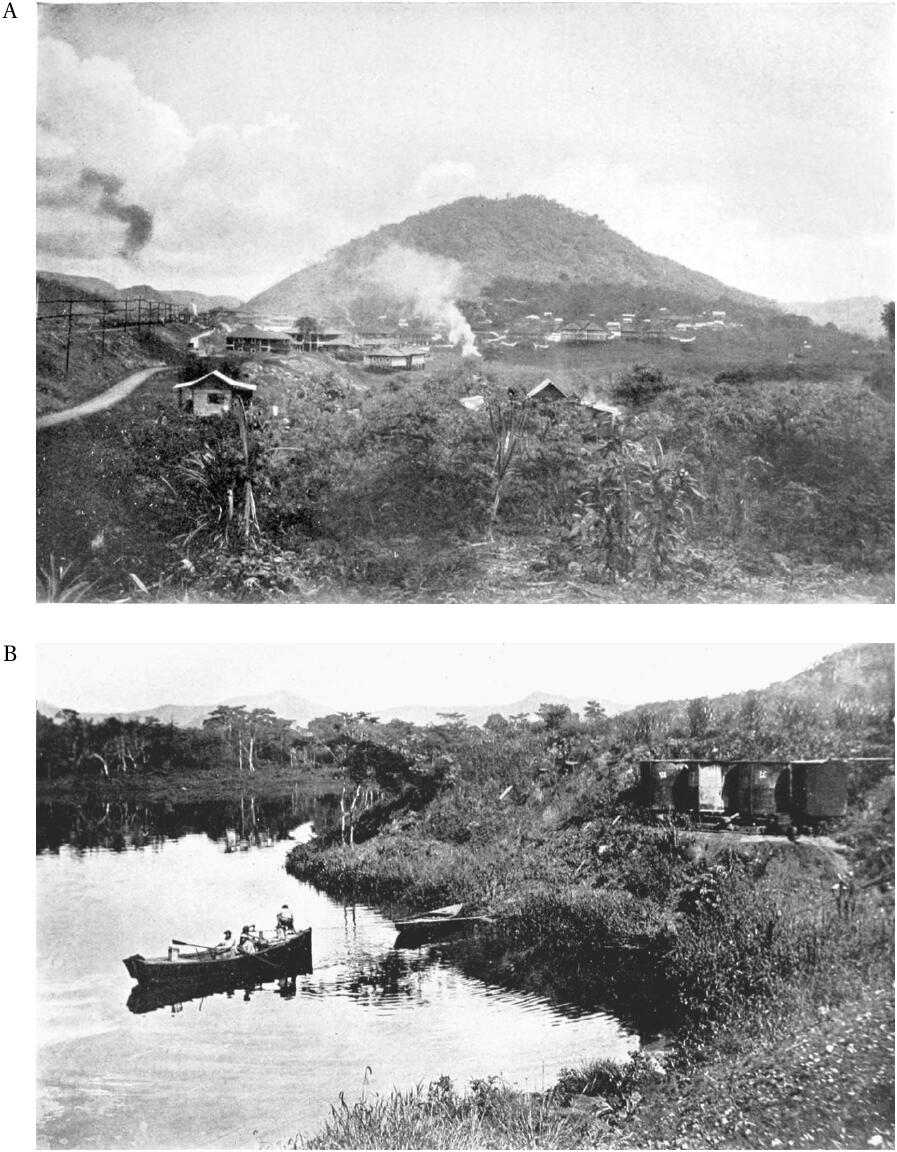
Pedro Miguel lies at the south end of the Cut, and on the opposite bank from Culebra. I visited it on the 26th May, and was met by Mr Mitchell, the sanitary inspector. Crossing the locks we reached a lake, formed by the partial blockage of the Rio Grande. The lake is half a mile from the houses, yet it is considered necessary to oil it. On the sides of the lake are four large oil tanks belonging to the Sanitary Department. From these the oil-boat is supplied which sprays the grassy edges of the lake. The tanks are connected with the trans-isthmian oil main by a pipe; and they deliver oil into the boat also by a pipe seen in the photo, thus diminishing the handling of oil.
Returning to the locks, Mr Mitchell told me fifteen men were employed for two days in oiling them, and that water suitable for Stegomyia was constantly being found. Every piece of machinery and every portion of the construction had to be scrutinised; the most unexpected places often contained water, as an example of which I might mention the tops of the tall concrete pillars on which the iron lamp standards were to be placed.
The Commission quarters are on the slope of the hill, and command a fine view. The land below will ultimately be covered by the Miraflores Lake, so permanent drainage has been carried down only to the 55-foot contour-level, i.e. the future lake level. Below this the drainage is carried off in earth drains, and these require much more supervision than the upper concrete portions. Beyond the houses we descended into the valley of the Pedro Miguel, a stream about 20 feet wide, with an average depth of about 9 inches. The bottom is stony, the current fairly fast in places; but there are a fair number of backwaters, which in the Federated Malay States would certainly harbour A. maculatus. The stream is not considered a danger except after a rise or subsequent fall of the water level, when larvae may be found in side pools. There was a good deal of scrub on the river banks, and my impression was that it did not receive much attention from the Sanitary Department, and therefore could not be as dangerous as a similar stream in the Federated Malay States. This may be, however, because all the small lateral feeders have been carefully oiled. I sincerely hope that the elimination of the lateral breeding places in Malaya will remove the danger of our larger streams.
Re-crossing the stream, we visited the incinerator, a simple but effective structure, the smoke of which is in the middle distance in Figure 10.17A. At the sanitary inspector’s office I was shown his system of working.
The district is divided into five parts, each of which is treated weekly. Saturday is called “Pick-up Day.” No less than two days in each week are spent in oiling the locks. The men may have their routine broken into by various emergency duties, and “Pick-up Day” allows any interrupted work to be completed.
At the railway station I noticed a mosquito-proof signal box where the holes in the walls through which the wires passed were carefully closed with cloth. Nothing seems to be overlooked in this work, nothing too insignificant to receive attention.
| 10.9 |
Paraiso |
On the 30th another spot in the sun—the electrically controlled clock in the hotel, being five minutes late, made me miss the train for Paraiso. Absit omen. However, after an eventful journey in a motor car, whose tyres seemed to have caught the explosive tone of the zone atmosphere, I arrived at my destination and found Major Noble. We then walked along the Cut to Paraiso, a town only the shadow of its former self, for most of it has disappeared into the Cut. Climbing down into the Cut, we walked along, examining the numerous springs which come from its sides until we came to the Cucaracha slide—one of the two longest on the Cut, and some 67 acres in extent. The oiling of this is very dangerous, as some of it is like a quicksand. In other places, as I saw when we reached the top later in the day, there are fissures and crevasses many feet deep. Two steam shovels working from north and south had met on the level of what is to be the bottom of the Cut, on the 20th May, but on the 26th, four days previous to my visit, the Cucaracha slide had moved forward and blocked it again. The photograph shows the new slide, and the shovels at work clearing it away. These slides are of interest, not only to the engineer but to the sanitarian, for a large slide may block the central drainage channel and create an extensive breeding area. Farther on I saw another slide, where the side of the Cut had sunk while the bottom had been heaved up and upset a steam shovel.
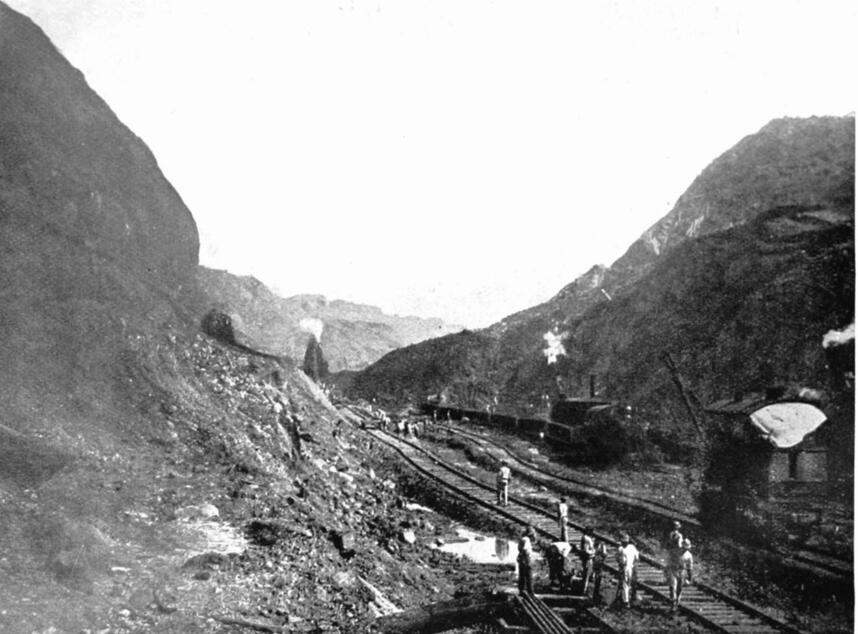
Opposite to the town of Culebra we climbed from one terrace to another out of the Cut, and had an excellent view of the terraces on the Culebra side of the Cut. On the way up I got a drink of iced water from an engine driver. Each engine and shovel is allowed 10 lbs. of ice each day, and part of the equipment of the engine is a vessel to contain water, which can be drawn off by a tap. Water is also provided for men on all the locks, and special supplies are sent to those working away from places where there are water-taps. This prevents the men from drinking from pools or streams which may be polluted.
We returned to Paraiso by the waggon road which runs behind Golden Hill, on the way climbing up the hill to look down on the Cucaracha slide. From this point the best idea of the enormous size the Cut can be obtained. It looks like half a mile to the top of the opposite bank; what it actually is I do not know. Some idea, too, is obtained of the great mass of earth which has been moving at intervals from the time of the French. Great fissures and crevasses covered its surface, and I was quite glad we had not attempted to climb up its face, as had been our original intention.
| 10.10 |
Colon. Cristobal. Mount Hope |
On 22nd May, with Mr Bath to Colon, where we were met by Dr Connor, who drove us to Mount Hope. Colon was built originally on a coral reef, and the town site has been made by filling. Between Colon and Mount Hope the road is just above the swamp, the original condition of which is still seen on the left.
The houses on the side of the road are built on piles; much like Malay houses, except that the piles are shorter, and the water at high tides runs under them. Although there is little scope for drainage, the swamp has a system of shallow drains, which to some extent concentrate the water and facilitate the oiling. Beyond the hill at Mount Hope we came to the edge of a deep swamp which extends from Mount Hope to Gatun. The engineers building the railway found great difficulty in getting the railway over it. No less does it present difficulty to the sanitarian; and the photographs in Figure 10.19 show how swampy the ground is in wet weather, despite the drainage.
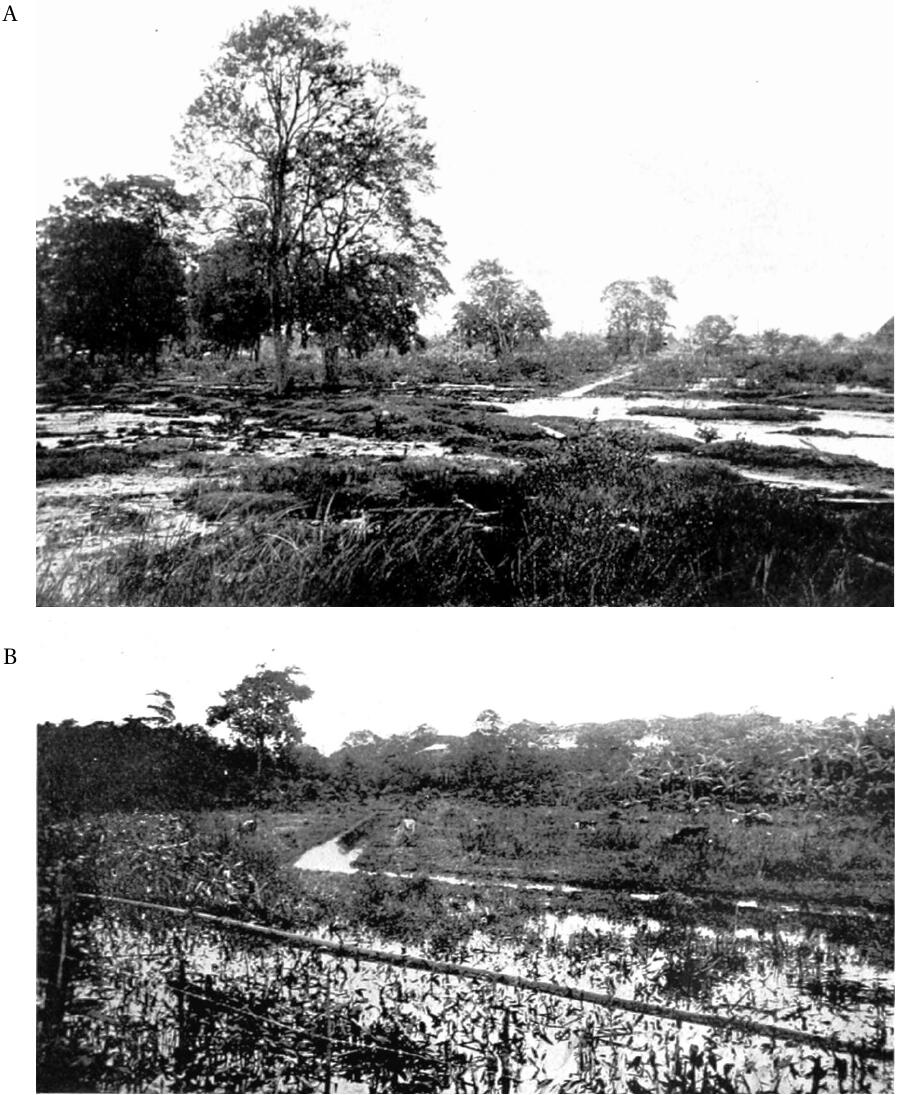
This system of drainage was constructed only in 1912. Year by year the drainage work on the zone has proceeded, and the health improved. It was on the hill at Mount Hope that the United States troops were so severely attacked by malaria when the zone was first occupied, and in this village Colonel Gorgas found 100 percent of the children with enlarged spleen. After walking round the village and visiting the cemetery, with its mournful record of young lives destroyed by yellow fever, we went back to Colon. It presents little of interest to the sanitarian, who finds it difficult to realise that the clean, well laid out town was originally a filthy, miserable swamp.
A visit to Toro Point on the 27th, however, gave me some idea of what the original site of Colon was. Toro Point is on the opposite side of the bay, and work is being carried out there in connection with the breakwater, which runs out 2 miles into the sea, and with the fortifications. The launch landed us on a little jetty fixed on the coral reef. The houses are built on the sea-beach, which is composed of coral sand; and behind them is a mud swamp, similar to what is seen between Colon and Mount Hope. Through the swamp drains have been cut, and into these the tide comes every day; only at spring-tide does the sea cover the swamp entirely.
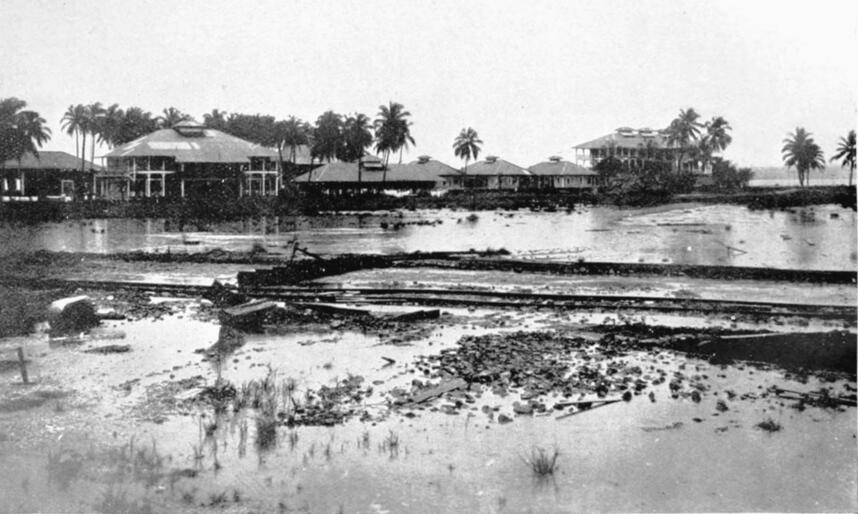
Beyond this salt-water swamp there are two extensive areas of freshwater swamp, about a quarter of a mile from the houses. These have been drained very thoroughly by a system of drains, which inter-communicate to prevent flooding should one of the outlets become blocked by shifting sand. About half a mile from the houses we came on a stream which we followed up for another half mile, when we came to the rock pools with Anopheles larvae. Some larvae were also found in backwaters; unfortunately they died, and I could not determine whether they were malefactor or albimanus. Larvae previously taken were, I understand, albimanus.
With swamps so extensive and so close to the houses, no one will be surprised to learn that when men were first stationed here, malaria had been severe. But the numbers in Table 10.2, which show how rapidly this was overcome, are indeed remarkable. In July and August 65.88 percent of the men were admitted to hospital, yet by the last week in the year the percentage was down to about 1/2 percent per week, and the total for the last five weeks was about 4.79 per cent. The measures which produced this result were screening, oiling, and mosquito catching. Drainage was completed later on. The corresponding period in 1912 is no less remarkable, and it is not without interest that from the 15th of January to the end of February, 1912, there was a great swarm of Anopheles in Toro Point, just as there was at Gatun at the same time. The two places, although on the same stretch of land, are fully 5 miles apart, and it was never actually determined whether the swarm originating in the hydraulic fill at Gatun had travelled through the jungle to Toro Point, or an independent breeding place had existed there. Mr Bath walked through the jungle from the one place to the other, finding the mosquitoes all the way; but he thinks it not impossible there were a series of breeding places, only some of which he found.
| 1910 | 1912 | |||||
| Week of | % | Week of | % | |||
| July | 2 | 9.16 | July | 6 | .62 | |
| 9 | 6.83 | 13 | 1.23 | |||
| 16 | 5.00 | 20 | .62 | |||
| 23 | 5.34 | 27 | .86 | |||
| 30 | 6.67 | August | 3 | .62 | ||
| August | 6 | 10.32 | 10 | .74 | ||
| 13 | 6.86 | 17 | .12 | |||
| 20 | 8.96 | 24 | .86 | |||
| 27 | 6.74 | 31 | .25 | |||
| September | 3 | 7.25 | September | 7 | .44 | |
| 10 | 3.74 | 14 | .44 | |||
| 17 | 4.64 | 21 | .29 | |||
| 24 | 7.68 | 28 | .29 | |||
| October | 1 | 7.28 | October | 5 | .00 | |
| 8 | 4.57 | 12 | .15 | |||
| 15 | 2.41 | 19 | .44 | |||
| 22 | 2.71 | 26 | .00 | |||
| 29 | 1.77 | November | 2 | .29 | ||
| November | 5 | 1.88 | 9 | .59 | ||
| 12 | 1.41 | 16 | .15 | |||
| 19 | 1.58 | 23 | .15 | |||
| 26 | 1.83 | 30 | .29 | |||
| December | 3 | 1.26 | December | 7 | .62 | |
| 10 | 1.21 | 14 | .62 | |||
| 17 | .65 | 21 | .00 | |||
| 24 | 1.11 | 28 | .00 | |||
| 31 | .56 | |||||
| 10.11 |
Corozal |
This town is nicely situated on sloping ground, but contains nothing of special interest in its history except the appearance of a great swarm of Anopheles in May 1912. Below the town is a mangrove swamp, part of which had been shut off by an embankment. When the rains appeared this embanked area became partially flooded; but, whereas in Gatun salt water had been poured on freshwater jungle, in Corozal, fresh water (rain) was poured and remained on saltwater jungle (the mangrove swamp). The result in both cases was a mixture of salt and fresh water, and in both there was an enormous swarm of mosquitoes. I could not ascertain whether in this instance there was any special feeding for the Anopheles, but it is probable that the alteration of the composition of the water killed some of the vegetable inhabitants of the swamp, and so provided food for A. albimanus.
| 10.12 |
Frijoles |
This station and Monte Lirio are small places on the new railway line, and their inhabitants came from villages now at the bottom of the Gatun Lake. On the 23rd May I visited Frijoles, and was shown round by Mr Smith, the sanitary inspector. The population consisted of about 150 souls, mostly negroes. There are a few Panamanians, and two white men, the station-master and the sanitary inspector. The latter is also in charge of Monte Lirio, a larger station. The people live in a few huts (“shacks,” as they are called), and the railway employees in screened railway cars.
No oiling or draining is done here or at Monte Lirio, because these stations are in the midst of dense jungle and extensive swamp, where neither oiling nor draining is possible. The only thing done is mosquito catching, and I watched a negro do this. With a “Baldwin candle”—that is, a very small acetylene lamp with a cage over the front instead of a glass—he went about the work in a way which showed he knew what he was about. Two men were employed in this work. We got about half a dozen Anopheles in two cars. The occupants are not particular about closing the doors at night; in the evening they often sit on the doorstep holding the door open with their knees. Among ten negro children I found five with enlarged spleen, and two out of three Panamanians were affected. The malaria admission rate from Frijoles is as low as from other stations. The old residents are, I think, probably immune, from former malaria, as they are the inhabitants of old Frijoles.
The employees do not depend for protection on the mosquito catching alone, for they live in screened houses; and as each car is screened separately, this is no inconsiderable degree of isolation. These stations cannot be considered as instances of the value of mosquito catching alone. The good health here results from screening and mosquito catching, and in the old inhabitants probably from the immunity acquired through previous infection.
| 10.13 |
The City of Panama |
On a rocky promontory jutting out into the Pacific Ocean stands the city of Panama, a quaint mixture of the new and the old world, of bygone and modern days. For it has grown slowly during three centuries, each of which has left its mark on the place and the people. Begun in the days when pirates and buccaneers were real dangers, when the honest citizen as he retired to rest prayed to be preserved from them that night, and meant it, the city still possesses part of the heavy walls and fortifications designed to keep out these freebooters. Wide modern boulevards cut across narrow passages, and plate-glass windows are intermingled with caged or latticed verandahs. The motor car hustles the mule and the little burro in the street. Celestial and Hindu bargain and trade with the American citizen, the Spaniard, the Panamanian and the San Bias Indian, whose forefathers fought the first European invaders of the Isthmus. True, there is still fighting in Panama, but it is when business is over, or at least suspended, and when the mixture of nations crowd to the prize ring to see what the proprietor advertises as “good, clean sport.”
In cleanliness apart from sporting, there has been a change for the better in later days. For pipes now bring pure water from the hills, and the old rain-barrel has disappeared. A sewer system saves the passer-by from a shower of slops from the upper storey, and removes what must always have been an element of excitement when ladies went to shop or promenade in the old days. So times and ways of doing things have changed, and this almost forgotten city has awakened to find itself, not only in the forefront of sanitation, but on one of the great highways of the world.
Yet, with all that has been done for sanitation in the city, I was surprised to find so many flies in the streets. There were more flies than are to be found in places like Singapore, Kuala Lumpur, or Medan, none of which can boast of being any cleaner than Panama. It is true that at long intervals a few flies have appeared in my house at Klang, Federated Malay States; but their appearance has always been the signal for a search for, and the destruction of, the breeding place, which is usually sawdust or the wood refuse of the firewood heap. Stable manure seems to be harmless here; but under no conditions in the Federated Malay States, even when extensive rubbish heaps exist uncovered, have I seen flies such as occur in a dry country like Egypt, or such as compel the inhabitants of the isolated stations in the Mojave Desert of America to screen their houses. I do not pretend to understand this; and I should add it was in Panama City, and not in any other settlement, that I found flies.